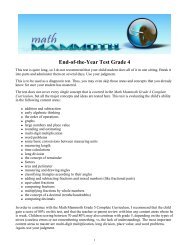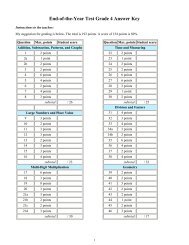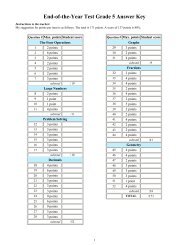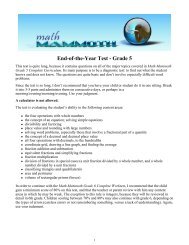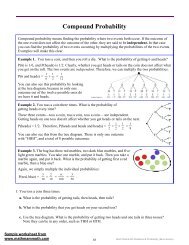Grade 4-B contents & samples - Math Mammoth
Grade 4-B contents & samples - Math Mammoth
Grade 4-B contents & samples - Math Mammoth
You also want an ePaper? Increase the reach of your titles
YUMPU automatically turns print PDFs into web optimized ePapers that Google loves.
Foreword<br />
<strong>Math</strong> <strong>Mammoth</strong> <strong>Grade</strong> 4-A and <strong>Grade</strong> 4-B worktexts comprise a complete math curriculum for the fourth<br />
grade mathematics studies, aligned to the Common Core Standards.<br />
In the fourth grade, students focus on multi-digit multiplication and division, learning to use bigger<br />
numbers, solving multi-step word problems that involve several operations, and they get started in<br />
studying fractions and decimals. This is of course accompanied by studies in geometry and measuring.<br />
The year starts out with a review of addition and subtraction, patterns and graphs. We illustrate word<br />
problems with bar diagrams and study finding missing addends, which teaches algebraic thinking.<br />
Children also learn addition and subtraction terminology, the order of operations, and statistical graphs.<br />
Next come large numbers—up to millions, and the place value concept. At first the student reviews<br />
thousands and some mental math with them. Next are presented numbers up to one million, calculations<br />
with them, the concept of place value and comparing. In the end of the chapter we find out more about<br />
millions and an introduction to multiples of 10, 100, and 1000.<br />
The third chapter is all about multiplication. After briefly reviewing the concept and the times tables, the<br />
focus is on learning multi-digit multiplication (multiplication algorithm). The children also learn why it<br />
works when they multiply in parts. We also study the order of operations again, touch on proportional<br />
reasoning, and do more money and change related word problems.<br />
The last chapter in part A is about time, temperature, length, weight, and volume. Students will learn to<br />
solve more complex problems using various measuring units and to convert between measuring units.<br />
In part B, we first study division. The focus is on learning long division and using division in word<br />
problems. In geometry, we first review area and perimeter, and then concentrate on the topic of angles.<br />
Students measure and draw angles, solve simple angle problems, and classify triangles according to their<br />
angles. They also study parallel and perpendicular lines.<br />
Fractions and decimals are presented last in the school year. These two chapters practice only some of the<br />
basic operations with fractions and decimals. The focus is still on conceptual understanding and on<br />
building a good foundation towards 5th grade math, where fractions and decimals will be in focus.<br />
When you use these books as your only or main mathematics curriculum, they can be like a “framework”,<br />
but you do have some liberty in organizing the study schedule. Chapters 1, 2, and 3 should be studied in<br />
this order, but you can be flexible with chapters 4 (Time and Measuring) and 6 (Geometry) and schedule<br />
them somewhat earlier or later if you so wish. Chapter 3 (Multiplication) needs to be studied before long<br />
division in Chapter 5. Many topics from chapters 7 and 8 (Fractions and Decimals) can also be studied<br />
earlier in the school year; however finding parts with division should naturally be studied only after<br />
mastering division.<br />
I wish you success in your math teaching!<br />
Maria Miller, the author<br />
Sample worksheet from<br />
www.mathmammoth.com<br />
5




